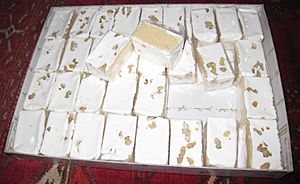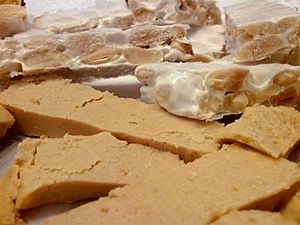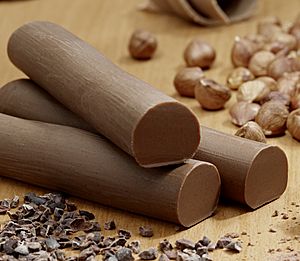Nougat facts for kids
|
Nougat bar
|
|
| Type | Confection |
|---|---|
| Main ingredients | White nougat: sugar or honey, nuts (almonds, walnuts, pistachios, hazelnuts), egg whites, sometimes candied fruit Brown nougat: sugar or honey, nuts (almonds, walnuts, pistachios, hazelnuts) Viennese or German nougat: sugar, nuts |
| Variations | Gaz (candy), torrone and turrón |
| 200 kcal (837 kJ) | |
Nougat (NOO-gət NOO-gah, or NUG-ət) is a sweet treat. It is a type of candy made with sugar or honey. It also contains roasted nuts like almonds, walnuts, pistachios, and hazelnuts. Sometimes, whipped egg whites and chopped candied fruit are added too.
Nougat usually has a chewy texture. You can find it in many different candy bars and chocolates. The word nougat comes from an old French word, pan nogat. This means 'nut bread' in Latin.
There are three main types of nougat. The most common is white nougat. This type is made with beaten egg whites and honey. It first appeared in Italy in the 1400s. It was also made in Spain in the 1500s and France in the 1700s.
The second type is brown nougat. This one is made without egg whites. It has a firmer, often crunchy texture.
The third type is Viennese or German nougat. This is like a chocolate and nut praline. It usually contains hazelnuts.
The Sweet History of Nougat
Many stories tell us about where nougat came from. The first recipes for white nougat likely came from Central Asia. They were found in a Middle Eastern book from Baghdad in the 900s. This early nougat was called nāṭif.
One recipe says that nāṭif came from Harran. This city was between Urfa (in modern Turkey) and Aleppo (in modern Syria). A traveler named Ibn Hawqal wrote that he ate nāṭif in Manbij (Syria) and Bukhara (Uzbekistan) in the late 900s.
Where Nougat is Popular
In Southern Europe, nougat is a very important part of Christmas meals.

You can find Turrón in Spain. Nougat is popular in Southern France. In Italy, it's called torrone, mandorlato, or cupeta. In Greece, it's known as mandolato. Malta has qubbajd, often sold at village festivals. In Romania, it's called alviță and sold at local fairs. A local version called Luka is found in Tabriz, Iran.
The nougat found in many modern candy bars in the United States and United Kingdom is a bit different. It's often a mix of sucrose (sugar) and corn syrup. It's made light and airy with things like egg white or gelatine. It might also have vegetable fats and milk powder. This type of nougat is cheaper to make. Large candy companies often use it as a filler. It's usually mixed with nuts, caramel, or chocolate.
Some American candies feature this whipped nougat as the main part. You can find varieties of nougat in Reese's Fast Break, Snickers, Double Decker, ZERO bars, and Baby Ruth bars. The 3 Musketeers bar is mostly whipped nougat.
In Britain, traditional nougat is made like the Southern European kinds. It's often sold at fairgrounds and seaside resorts. The most common type made in factories is pink and white. The pink part often has a fruit flavor. It's sometimes wrapped in edible rice paper with almonds and cherries.
Different Kinds of Nougat
Spanish turrón uses traditional recipes. It has toasted nuts (usually almonds), sugar, honey, and egg whites.
Torrone from Italy uses the same basic ingredients. It often has vanilla or citrus flavors. It is sometimes placed between two very thin sheets of rice paper. The town of Cologna Veneta in Italy is famous for its nougat. They make a type called mandorlato. This kind is always made with honey, sugar, egg whites, and almonds. It has a different taste and is harder to bite than torrone.
"Wiener (Viennese) Nougat" is a special type. It only contains sugar, cocoa butter, nuts, and cocoa mass. It has a smooth, soft texture. The nuts used for Viennese nougat are usually hazelnuts. In Germany and Nordic countries, this is what people usually call nougat. In Sweden and Denmark, the original chewy nougat is called "French nougat." In Germany, a chocolate spread called gianduja is also traditionally called nougat.
See also
 In Spanish: Nougat para niños
In Spanish: Nougat para niños




